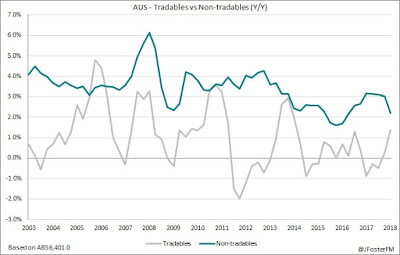Meanwhile, in separately released data prices for Australian goods exported increased more strongly than forecast in the September quarter.
International Trade – September | By the numbers
- Australia's trade surplus in September was $A3.017bn, which far exceed the market forecast for a surplus of $1.7bn. August's surplus, previously reported at $A1.604bn, was revised sharply higher to $2.342bn.
- Export earnings increased by $283m, or 0.8%, to $37.496bn
- Import values declined by $392, a fall of 1.1%, to 34.479bn
- Australian export goods prices increased by 3.7% in Q3 (exp 2.2%), to be 14% higher over the year
- Import prices lifted by a softer 1.9% (exp 1.0%) in the quarter and 9.8% in annual terms
International Trade – September | The details
On the exports side of the equation, total earnings lifted by $283m to $37.496bn, which was largely the result of a $678m rise from earnings derived from exports of non-rural goods.
Specifically, metal ores and minerals (mainly iron-ore) surged by 7%, or $551m, to a touch above $8bn. The ABS reported that this was mainly attributable to higher prices, with lump rising by 5% and fines by 4%. Also contributing was a 6%, or $270m, increase in earnings from other mineral fuels, which totaled $4.942bn. This was driven by higher prices for LNG exports. Meanwhile, rural goods earnings were little changed rising by $33m to $4.211bn.
Moderating these increases, earnings from coal exports eased by 3%, or $141m, to $5.406bn following broad-based declines in prices and volumes. The main weight to export earnings was non-monetary gold – a typically volatile component – which declined by $525m, or by 26%, to $1.498bn.
Services exports posted a 1% rise to $8.156bn, accounting for around 22% of total export earnings. Tourism saw a 2% increase in the month to $5.627bn.
On the imports side, the total value of goods and services imported fell by $392m in September to $34.479bn. This mainly reflected a $607m drop in the value of capital goods imported, where the weakness was broad based across the categories including civil aircraft (-$299m) and machinery and equipment (-$107m). Non-monetary gold also declined by $59m to $359m.
The services imports bill was little changed in September, rising by $11m to $8.165bn. Overseas tourism declined by 1%, or $25m, to $4.754bn. 'Other services', including business services, were flat at $2.931bn.
International Trade – September | Insights
With all data for Q3 now to hand, the ABS reported that its preliminary estimate for the trade surplus in the quarter on a seasonally adjusted basis was $6.404bn, which is some 52% higher than the surplus recorded in Q2. However, that escalation in the trade surplus over the quarter appears to be reflective of stronger commodity prices, which offset declines in volumes exported. Net-exports, which reflect volumes only, may therefore only contribute marginally to economic growth in Q3. The trade prices data would support this view, which implied a Terms of Trade boost of 1.1%, driven by price increases in LNG, iron-ore, and coal.































